1) Sex Determination
Establishment of sex through differential development in an individual at an early stage of life, is called sex
determination. There are different methods for sex determination in organisms like environmental, non-allosomic genetic determination, allosomic sex determination and haplodiploidy.
2) Sex Determination on the basis of fertilization.Three types:
1. Progamic – Sex is determined before fertilization.
eg. - drone in honey bee
2. Syngamic - Sex is determined during fertilization.
eg. - most of plants & animals
3. Epigamic - Sex is determined after fertilization.
eg. - Female in honey bee.
Environmental Determination of Sex. It is non-genetic determination of sex which is based purely on environmental conditions. The organisms are potentially hermaphrodite and capable of expressing any of the two sexes.
1. In marine worm Bonellia, larva develops into female if it settles down alone in an isolated place. Any larva coming in contact with the already grown female, it changes into male, and lives as a parasite in the uterus of female.
2. Crepidula (marine mollusca) where larva develops into male in the company of female and develops into femaleifleftalone.
3. In crocodiles low temperature induces femaleness and high temperature maleness.
4. ln turtles temperature below 28°C induces maleness, above 33°C femaleness while between 28 - 33°C equal number of male and female animals are formed.
5. In marine fish Medusa sex changes according to environmental condition, becoming male in cold water and female in warm water.
Allosomic determination of sex:
Chromosomes are of two types -
(a) Autosomes or somatic chromosomes - These regulate somatic characters.
(b) Allosomes or Heterosomes or Sex chromosomes - These chromosomes are associated with sex determination. Term "Allosome" & "Heterosome" were given by Montgomery.
Sex chromosomes first discovered by "Mc Clung" in grass hopper
X- Chromosome discovered by "Henking" and called 'x-body'.
Wilson & Stevens proposed chromosomal theory for sex determination.
(1) XX - XY type or Lygaeus type :- This type of sex determination first observed by Wilson & Stevens in
Lygaeus insect. Two types–
(a) XX female and XY male :- In this type of sex determination female is Homogametic i.e produces only
one type of gamete
Male is heterogametic (male produces two types of gamete)
In male X-chromosome containing gametes is called "Gynosperm" and Y- chromosome containing gamete is called "Androsperm".
eg. Man and dioecious plants like Coccinea, Melandrium
(b) XY female and XX male or ZW female and ZZ male :- In this type of sex determination female is
Heterogametic i.e produces two types of gamete and male individual is homogametic i.e produces one
type of gamete.
It is found in some insects like butter flies, moths and vertebrates like birds, fishes and reptiles.
In plant kingdom this type of sex determination is found in Fragaria elatior.
(2) XX female and XO male :- or "Protenor type" :- In this type of sex deternination deficiency of one chromosome in male. In this type, female is homogametic and male is heterogametic.
Example :–
– Grass hopper
– Squash bug Anasa
– Cockroach
– Ascaris and in plants like - Dioscorea sinuta & Vallisneria spiralis
Genic balance theory :- C.B. Bridges proposed genic balance theory for sex determination in Drosophila.
– According to Bridges in Drosophila Y-chromosome is heterochromatic so it is not active in sex determination
In Drosophila sex determination takes place by sex index ratio.
In Drosophila gene of femaleness (Sxl- gene) (Sxl=Sex lethal gene) is located on x-chromosome and gene of
maleness is located on autosome
Gene of male fertility is located on y-chromosome and in Drosophila, y-chromosome plays additional role in
spermatogenesis and development of male reproductive organ, so y-chromosome is essential for the production offertilemale.
Sex index ratio
(c) X/A = 1.5 → Super female or meta female (sterile) (2A + XXX)
(d) X/A = less than 0.5 → Super male or meta male (Sterile) (3A + XY)
(e) X/A = = In between 0.5 and 1 → Intersex (Sterile) (3A+XX)
Gynandromorph
Body of some Drosophila has some cells with male genotype (X0) and some cells with female genotype (XX).
Body of such type of Drosophila has half lateral part of male and half lateral part of female and it is called bilateral gynandromorph. It is formed due to loss of one x-chromosome at metaphase plate during first zygotic division. Formation of gynandromorph is the best evidence that y-chromosome does not play any role in sex differentiation.
Haploid - diploid mechanism
In insects of order Hymenoptera which includes ants,honey bees, wasps etc.
Sex determination takes place by sets of chromosomes.
Diploid (two sets) → Female
Haploid (One set) → Male
In honey bee, male individual (Drone) develops from unfertilized eggs (Haploid). Male is always parthenote.
Queen and worker bees develop from diploid eggs i.e. fertilized egg.
Sex determination by Hormone
Dizygotic twins are common in cattle like cow, sheep, goat etc. Some times the placentae of the two dizygotic
twins fuse forming blood vascular connections between two developing foetus. If twins are dizygotic, one
foetus may be male and the other female.
Male hormone produced before female hormone by male twins which suppresses the differentiation of female internal sex organ. Such a sterile female with Under developed ovaries, oviducts, Uterous etc. is called free martin. In free martin conditions, female is sterile & male is normal.
Cytological basis of sex determination
Barr body technique or Lyon's hypothesis -
Interphasic nucleus of human female contains two X- chromosomes. Out of two, one X- chromosome becomes heterochromatin and other X- chromosome is euchromatin. By staining X- heterochromatin, it appears as a dense body which is called Barr body. (Facultative hetrochromatin)
No. of Barr body ⇒ (No. of X chromosomes – 1)
So in a Normal female (2A + XX) → One Barr body
Normal male (2A + XY) → Barr body absent
Turner syndrome (Sterile female) (2A + XO) → No. Barr body
Klinefelter syndrom (Sterile male)(2A + XXY) → One Barr body
Drum stick which occurs in blood of female of mammals, is also a type of barr body. Drum stick is absent in neutrophils of Male.
Sex determination in human
There occur a special gene on differential region of Y-chromosome of human, called Sry - gene (Sex determine region on y chromosome ). This gene forms a proteinaceous factor called TDF (testes determining factor). TDF responsible for the development of male reproductive organs. So presence and absence of Y- chromosome determines sex.
Sex determination in plant
H.E. Warmke discovered sex determination in Melandrium plant. In Melandrium Y- chromosome is long as compare to X- chromosome. In plant sex chromosomes are found only in unisexual plant. Pro. R.P. Roy gave the importance of Y-chromosome in plant. He discovered sex determination in Coccinea indica (Family- cucurbitaceae) Y- chromosome contains four regions and X- chromosome contains two regions. Different functions of these regions-
Ist region - (Female suppressor region) :- This region suppresses the development of female reproductive structures.
IInd region (Male promotor region) :- This region initiates or start the development of Anther
IIIrd region (Male fertility region) :- This region induces the further development of Anther.
IVth region (Homologous region) :- This region helps in the disjunction & Pairing of X and Y chromosome during meiosis.
Vth region (Differential region of X-chromosome) :- This region induces the development of female gonads
So when one or more than one Y- chromosome present then plant is male and in female plant Ychromosome
is absent.
Special Case :
If Ist region of Y chromosome is removed then plant becomes bisexual (XY).
If IInd region of Y chromosome is removed then plant becomes female due to absence of IInd region, Ist region of Y chromosome does not suppress the Vth region of X-chromosome.
If IIIrd region of Y chromosome is removed then plant become sterile male due to absence of IIIrd region so further development of anther does not take place.
PHENOTYPIC EXPRESSION IN HAPLOID ORGANISMS (Neurospora Genetics)
Diploid organisms such as pea and Drosophila, have two alleles for each gene on each chromosome (the exceptions are for the X linked genes in XY or XO males). With the result, the recessive allele is not expressed
in the phenotype in presence of the dominant one. However, this is not so in the case of haploid organisms. Contrary to diploid organisms, the genetics of haploid organisms exhibit the following features:\
1. Haploid organisms contain only one allele of a gene, so there is no complication of dominance. All the
genes, whether dominant or recessive, expresses itself in the offsprings.
2. In absence of dominance, any new mutation is immediately expressed in the phenotype, in haploid
organisms.
3. Study of inheritance of the mutated gene, its linkage, crossing over and biochemical consequence of a
mutation can easily be studied in haploid.
Linkage And Recombination in Neurospora (Drosophila of plant kindgom)
Detection of linkage and recombination of genes in haploid organisms as in fungi, bacteria etc. is comparatively
simple. Fungus Neurospora is one of the favourite material with geneticists, because :-
1. The life cycle of Neurospora is the product of a single meiosis.
2. The life cycle is of a short duration.
3. The meiotic products are linearly arranged in ascus as 8 ascospores as ordered tetrads (i.e, the eight
ascospores are arranged in the same order in which chromatids were on the meiotic metaphase plate).
Tetrad Analysis in Ordered Tetrads
In Neurospora, the nuclei from hyphae of opposite mating type (+) and (–) fuse to form a diploid zygote. The
zygote is the only diploid stage in the life cycle of Neurospora. The zygote nucleus divides meiotically producing four haploid nuclei, each of which then undergoes mitosis. The eight cells produced this way, form 8 haploid ascospores enclosed in the ascus. The three divisions proceed along the longitudinal axis, so the ascospores are arranged in a line in a specific order that indicates the order of arrangement of chromatids on the meiotic metaphase plate. This is called linear or ordered tetrad. Each of the four products of meiosis can be cultured separately to study their phenotypes and genotypes. This is called tetrad analysis.
1. First Division Segregation Between Centromere and gene-a.
A cross between two strain of Neurospora, one normal (a+) and other mutant (a) strain produces 8-ascospores, out of which four are normal (a+) and other four mutants (a). The linear arrangement of ascospores in ascus is 4a+ : 4a. It indicates the absence of crossing over between locus-a and centromere. This is described as first divisionsegregation.
2. Second Division Segregation Between Centromere and Gene-a.
In a similar cross if crossing over takes place leading to paired arrangement of ascospores with a particular gene, it is described as second division crossing over. The arrangement of ascospores in the sequence ( 2 : 2: 2 : 2) is as follows:
(i) a+ : a+ : a : a : a : a : a+ : a+
(ii) a : a : a+ : a+ : a+ : a+ : a : a
(iii) a+ : a+ : a : a : a+ : a+ : a : a
Single Gene Mapping in Neurospora
In Neurospora centromere behaves as a gene for mapping gene pair. In such a case distance of gene from the
centromere is calculated by calculating the percentage of cross overs between centromere and gene.
Que. If 10% asci show crossing over in ascocarp what will be distance between gene and centromere.
If total 100 asci are present in a Neurospora
asci is derivative of 4 chromatids
100 asci are derivative of 400 chromatids = total chromatids
10 asci are derivative of 40 chromatids
(Out of 40 only 20 will be the recombinant type)
Sex Determination (Complete Notes) | Genetics
![Sex Determination (Complete Notes) | Genetics]() Reviewed by Rajkumar
on
February 16, 2019
Rating:
Reviewed by Rajkumar
on
February 16, 2019
Rating:





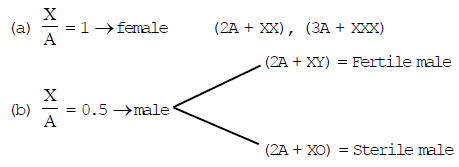
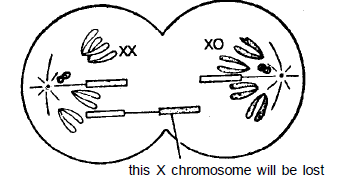

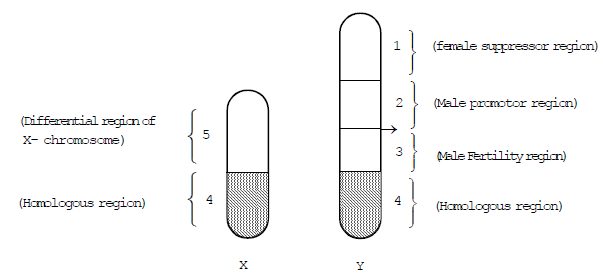
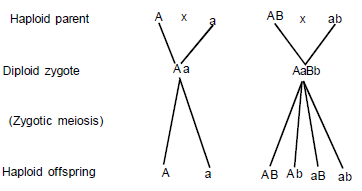
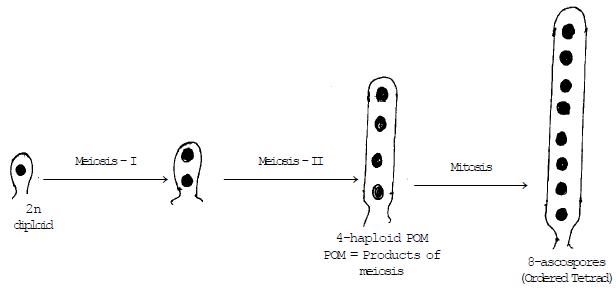




No comments: